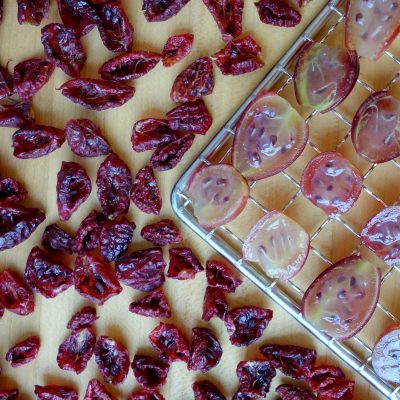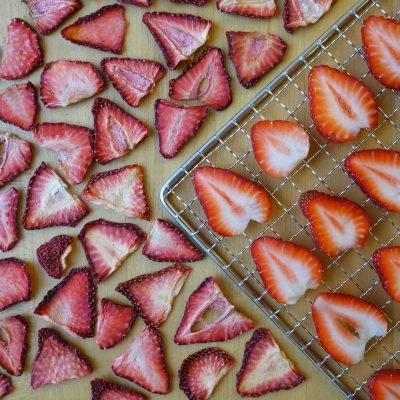
Dehydrating Fruit
Drying your own fruit is a wonderful way to preserve food and avoid wasting extra produce before it goes bad. In addition to its nutritive benefits, dehydrated fruit is also lightweight and compact, making it easy to store and use, especially for on-the-go snacking. Fruits that dry well for snacks are apples, apricots, bananas, and pears. Fruits can also be turned into purees and dried as leathers.
One of the oldest food preservation methods, dehydration works by heating fruit until almost all of the moisture—about 80 percent—has evaporated from your food. Successful drying depends on heat, low humidity, and good air circulation. The Sahara Folding Dehydrator delivers the ultimate combination of those three factors, as well as a simple dual time/temperature control to ensure the optimal settings for dehydrating your favorite fruits.
How to Dry Fruit
Step 1 — Select Superior Produce
Good dried fruit starts with good produce. Select fresh, fully-ripened fruits for the best color, flavor, texture, and nutritional value once dried. Drying will not improve your food quality if it is under- or overripe!
Step 2 — Prep, Peel, Or Crack Your Fruit
Wash your produce in cool water with a brush to remove any soil and other residue. Drain and dry thoroughly. If necessary, slice into even pieces, remove seeds, and/or core, then prepare foods as described below. Peeling fruits like apples and pears is optional.
Fruits with a tough, wax-like skin such as grapes, plums, cherries, cranberries, goldenberries, and figs need to be “cracked” before drying as a whole fruit to allow moisture inside the fruit to evaporate. Crack skins by quickly dipping fruit into boiling water for 30 to 60 seconds before submerging them in very cold water. Any skins not cracked during this process can be partially sliced, making small cuts with a knife. Drain and dry the fruit on absorbent towels before dehydrating.

Step 3 — Time to Dry
Evenly space your fruit pieces on drying racks without allowing them to touch. There should be a small amount of space surrounding each piece. Because food shrinks as it dries, smaller fruits like blueberries should be placed on our food-safe silicone drying mats.
Stick to the same type of fruit for each batch of drying. For example, mixing varieties of citrus fruits cut in the same thickness is fine. But avoid mixing fruits that require different times or temperatures for dehydration, such as melons or grapes mixed with citrus.

You want your fruit dry enough to stop any mold or spoilage from happening during storage. The ideal drying time depends on the type, thickness, and moisture content of the fruit you are drying. Select the right time and temperature setting following the guidelines below. This may take some experimenting on your part to find the perfect settings.
Do not try to speed up the drying process by turning up the temperature. This will dry the outside of your fruit before the inside, which is called case hardening. Your fruit will appear dry on the outside, but moisture will be trapped inside, causing your fruit to mold in storage.
Dehydrated fruits should be leathery and pliable. Test for the perfect dryness by removing a few pieces from the dehydrator, cooling to room temperature, and squeezing between your fingers. If no moisture forms on your hand or the fruit and the pieces spring apart when released, they are dry!
How Long Does Dehydrated Fruit Last?
Once dry, allow fruit to "condition" for a few days before storing. This is done by loosely packing dehydrated fruit into air-tight containers and occasionally shaking to evenly distribute the remaining moisture. If condensation forms inside the container, more dehydration is needed. To help retain nutrients, package dried and conditioned fruits in tightly sealed containers (like glass jars) or vacuum seal and store in a cool, dry place. Dried fruit is best used within a year, but the length of storage time will depend on the moisture content and whether it is stored in the fridge.

How to Use Dehydrated Fruit
Dried fruit pieces can be eaten as snacks or used in your favorite recipes. We love using it in our homemade granola. It can also be turned int powder. Superfood powders make a great addition to smoothies and herbal tea or can be turned into delicious toppings like blueberry sugar.
If creating a fruit powder, we recommend cutting your dehydrated fruit into small pieces and freezing it for 10 minutes before grinding to prevent it from gumming up your grinder or food processor. (The fruit sugar tends to get sticky and tacky when warmed by the blades).
Best Fruit to Dehydrate
Fruits that dry well for snacks are apples, strawberries, bananas, and pears, but the best fruit for dehydration is up to you! Keep in mind that although dehydrating fruit is relatively simple, it is not an exact science. Trial and error with your time and temperature settings is often needed to perfect this process at home. The Sahara Dehydrator’s simple-to-use dual time/temperature control allows users to program two times and two temperatures, ensuring food is adequately dried without compromising the flavor and texture of your fruit.
Explore our recommendations below for prep, time, and temperature for dehydrating a variety of different fruits.

Apples
- Time 1: 8 hours; Time 2: 1 hour
- Temperature 1: 135ºF Temperature 2: 165ºF

Apricot
- Time: 24-30 hours
- Temperature: 130ºF / 54ºC

Banana
- Prep: Thinly slice
- Time: about 12 hours
- Temperature: 135ºF / 57ºC

Blackberries
- Time: 18-30 hours
- Temperature: 135ºF / 57ºC

Blueberries
- Prep: Slice in half or blanch 30–60 seconds to crack skin
- Time: 8-18 hours
- Temperature: 135ºF / 57ºC

Cantaloupe
- Time: 18-20 hours
- Temperature: 135ºF / 57ºC

Cherries
- Prep: Blanch 30–60 seconds to crack skin
- Time: 24 hours
- Temperature: 135ºF / 57ºC

Cranberries
- Prep: Blanch 30–60 seconds to crack skin
- Time: 30 hours
- Temperature: 135ºF / 57ºC

Dragonfruit
- Time: 10 hours
- Temperature: 131ºF / 55ºC

Figs
- Prep: Blanch 30–60 seconds to crack skin
- Time: 12-24 hours
- Temperature: 135ºF / 57ºC

Golden Berries
- Prep: Blanch 30–60 seconds to crack skin
- Time: 18-20 hours
- Temperature: 135ºF / 57ºC

Gooseberries
- Time: 18-20 hours
- Temperature: 135ºF / 57ºC

Grapefruit
- Time: 12 hours
- Temperature: 135ºF / 57ºC

Grapes Black
- Prep: Blanch 30–60 seconds to crack skin
- Time: 24-48 hours
- Temperature: 135ºF / 57ºC

Grapes Green
- Prep: Blanch 30–60 seconds to crack skin
- Time: 24-48 hours
- Temperature: 135ºF / 57ºC

Grapes Red
- Prep: Blanch 30–60 seconds to crack skin
- Time: 24-48 hours
- Temperature: 135ºF / 57ºC

Grapes Thomcord
- Prep: Blanch 30–60 seconds to crack skin
- Time: 24-48 hours
- Temperature: 135ºF / 57ºC

Honeydew
- Time: 8-10 hours
- Temperature: 135ºF / 57ºC

Kiwi
- Time: 6-12 hours
- Temperature: 135ºF / 57ºC

Kiwi Berries
- Time: 6-12 hours
- Temperature: 135ºF / 57ºC

Kumquat
- Time: 6-8 hours
- Temperature: 135ºF / 57ºC

Lime
- Time:12 hours
- Temperature: 135ºF / 57ºC

Lemon
- Time: 12 hours
- Temperature: 135ºF / 57ºC

Mango
- Time: 12 hours
- Temperature: 135ºF / 57ºC

Mandarin Orange
- Time: 12 hours
- Temperature: 135ºF / 57ºC

Melon Pepino
- Time: 8-10 hours
- Temperature: 135ºF / 57ºC

Oranges
- Time: 12 hours
- Temperature: 135ºF / 57ºC

Papaya
- Time: 6-9 hours
- Temperature: 135ºF / 57ºC

Peaches
- Time: 8-12 hours
- Temperature: 135ºF / 57ºC

Pear Bartlett
- Time: 8-10 hours
- Temperature: 135ºF / 57ºC

Pear Bosc
- Time: 8-10 hours
- Temperature: 135ºF / 57ºC

Pear D’anjou
- Time: 8-10 hours
- Temperature: 135ºF / 57ºC

Pear Forelle
- Time: 8-10 hours
- Temperature: 135ºF / 57ºC

Pineapple
- Time: 8 hours
- Temperature: 135ºF / 57ºC

Plantain
- Time: 12 hours
- Temperature: 135ºF / 57ºC

Plum
- Prep: Blanch 30–60 seconds to crack skin
- Time: 20 hours
- Temperature: 135ºF / 57ºC

Raspberries
- Time: 24 hours
- Temperature: 135ºF / 57ºC

Starfruit
- Time: 10 hours
- Temperature: 125ºF / 52ºC

Strawberries
- Time: 10 hours
- Temperature: 135ºF / 57ºC

Watermelon
- Time: 18-20 hours
- Temperature: 135ºF / 57ºC
















